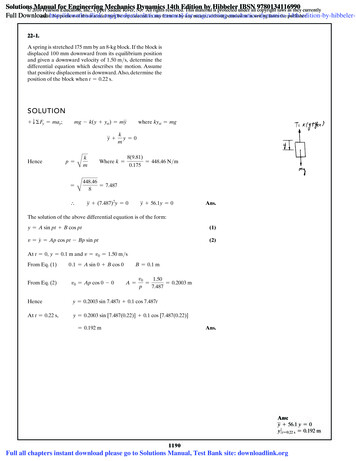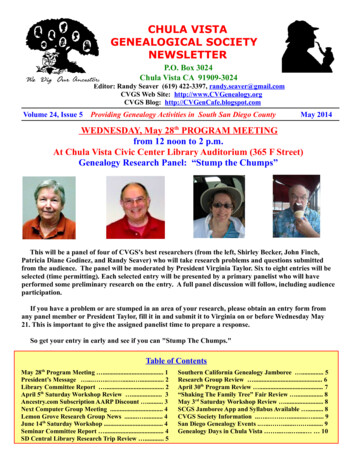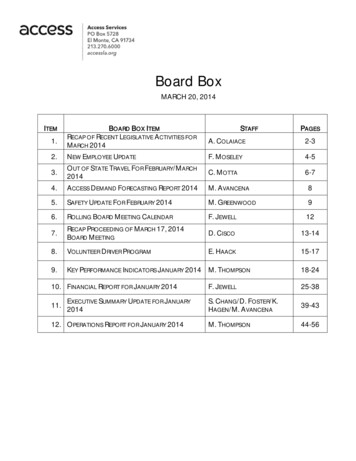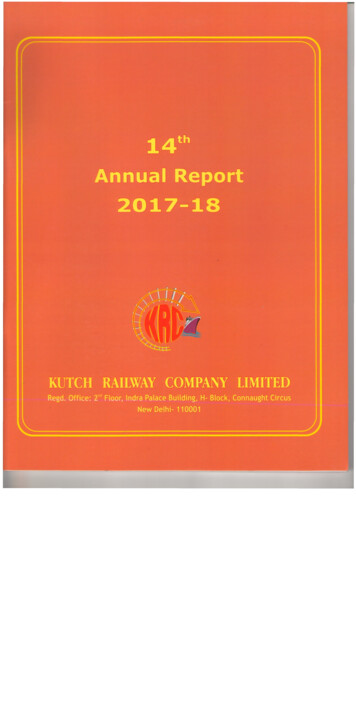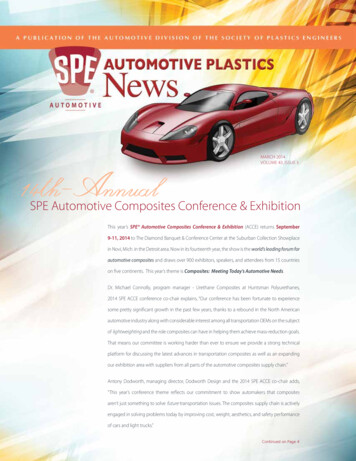
Transcription
14th-AnnualMARch 2014Volume 43, Issue 3SPE Automotive Composites Conference & ExhibitionThis year’s SPE Automotive Composites Conference & Exhibition (ACCE) returns September9-11, 2014 to The Diamond Banquet & Conference Center at the Suburban Collection Showplacein Novi, Mich. in the Detroit area. Now in its fourteenth year, the show is the world’s leading forum forautomotive composites and draws over 900 exhibitors, speakers, and attendees from 15 countrieson five continents. This year’s theme is Composites: Meeting Today’s Automotive Needs.Dr. Michael Connolly, program manager - Urethane Composites at Huntsman Polyurethanes,2014 SPE ACCE conference co-chair explains, “Our conference has been fortunate to experiencesome pretty significant growth in the past few years, thanks to a rebound in the North Americanautomotive industry along with considerable interest among all transportation OEMs on the subjectof lightweighting and the role composites can have in helping them achieve mass-reduction goals.That means our committee is working harder than ever to ensure we provide a strong technicalplatform for discussing the latest advances in transportation composites as well as an expandingour exhibition area with suppliers from all parts of the automotive composites supply chain.”Antony Dodworth, managing director, Dodworth Design and the 2014 SPE ACCE co-chair adds,“This year’s conference theme reflects our commitment to show automakers that compositesaren’t just something to solve future transportation issues. The composites supply chain is activelyengaged in solving problems today by improving cost, weight, aesthetics, and safety performanceof cars and light trucks.”Continued on Page 4
An Engineer’s Life.AUTOMOTIVEby Roger AssakerCEO, e-Xstream engineering andChief Materials Strategist, MSC SoftwareIwas born in Lebanon in October of 1968 as the youngest ofthree brothers. I grew up and lived in Lebanon until the end ofhigh school in 1987 when I left to go abroad for university. Inmy home country, we are basically encouraged to get a goodeducation, and most choose a career in either medicine or inengineering. I went the route of engineering. My father wasa landscape architect who was passionate about math. OneBefore I’d even finished my Ph.D., I started my first full-time job as aSenior R&D Engineer in the Computational Mechanics Group at theGoodyear Technical Center in Luxembourg. Once again, my brotherDany arrived before me and helped me obtain an interview for ajob that I was offered. It really was nice to be able to work with himand a team of friends. My work there was focused on developingmethods and software for the effective and efficient modeling andsimulation of tires. Our company, as many other major corporations,had invested millions of dollars in finite-element analysis (FEA)simulation working with all the major commercial software codes.However, when it came to material modeling for those commercialpackages, we found that this area of work was underfunded andunderdeveloped. To do my job, I mainly collaborated with SandiaNational Laboratories in the U.S. and with different FEA softwarevendors working on topics such as fluid-structure interaction anduncertainty quantification. My work at Goodyear gave me theopportunity to issue a couple of trade secrets related to advancedmodeling of tires. While working there, I completed my Ph.D.dissertation and then started work on an M.B.A. by taking eveningclasses at Sacred Heart University’s John F. Welch College of Businessin Luxembourg. I graduated as valedictorian in the Class of 2002.During my time as an M.B.A. student, I worked on a business planto start e-Xstream engineering. After 5-1/2 years at Goodyear, Itook a big risk and walked away from a nice career plan, and acomfortable salary and benefits at the end of 2002. I wanted tofocus on starting my own company with my long-time colleague,Issam Doghri, whose research at University of Louvain focused inof my brothers, Richard, who is 11 years older than me, is aprofessor of Neurosurgery in Lille, France and has inventedmany medical devices. My other brother, Dany, who is 8 yearsolder than me, holds a Master’s degree in Civil Engineering anda Ph.D. in Aerospace Engineering. These days he is a managerat the Goodyear Technical Center in Luxembourg.I finished a combined Bachelor’s/Master’s degree in AerospaceEngineering in 1992 at the University of Liège in Belgium. While Iwas working on that degree, my brother Dany worked at Solvay’sheadquarters in Brussels and helped me get the opportunity todo a couple of summer internships at the company. That provedto be my first contact with plastics. After graduating, I continuedmy education by following in Dany’s footsteps and pursuing aPh.D. degree at the University of Louvain, also in Belgium. Mydoctorate was in MagnetoHydroDynamics in Semiconductors. Ichose Aerospace Engineering because it sounded exciting andbecause it was strongly computational mechanics and simulationbased, and I loved that kind of work. While I was pursuing myPh.D. degree, I did some teaching in solid mechanics and strengthof materials, and that’s where I met my future business partner,Professor Issam Doghri, who had recently left California afterworking for a software company for some years. A decade later,we co-founded e-Xstream engineering.12
An Engineer’s LifeContinued from page 12material modeling and micromechanics. Interestingly, the businessplan I wrote for e-Xstream won 2 competitions at regional (123GO)and European (Eurowards) levels of competition, and that helped usnot only get a lot of free publicity, but also to meet two of the threeinvestors who eventually would help fund the company’s startup.Today I am married to Florence, whom I tutored in math when wewere both at university and she was studying Economics. Together,we have a 12-year-old daughter called Anouk, who is crazy abouthorses, and is showing great aptitude in math as well as earlyindications of an entrepreneurial spirit, since she wants to start ahorse ranch. I like all kinds of outdoor and water sports, includingscuba diving, sailing, snowboarding, and running — that is, whenI’m not on a plane.We began operations in May of 2003 and our first office wasin Belgium. Less than a year later, we set up a second office inLuxembourg. Issam stayed at University of Louvain but worked as aconsultant for us as head of R&D, a position he still holds. e-Xstreamengineering is a software and engineering services company thatis 100% focused on multi-scale modeling of reinforced plasticsand composites. The company has been experiencing doubledigit growth for the past decade and today is a key player in thematerials modeling segment. Automotive is our most importantmarket, followed by aerospace. It’s funny but we see automotivemoving from plastics toward composites, and aerospace movingfrom composites toward reinforced plastics, so we think we arepositioned well to help both industries, since their needs overlapour core competence.And my two brothers? Although we aren’t working together atthe moment, when we play golf we come up with 10 new ideasan hour. My surgeon brother has brought me in to help design anew medical device that replaced titanium with PEEK/carbon fibercomposite for an intervertebral disc replacement. Who knowswhat the future will hold?ABOUT ROGER ASSAKERRoger Assaker, a tech entrepreneur, is CEO and co-founder ofWhile I worked to build e-Xstream, I continued my educationstudying entrepreneurship (at Massachusetts Institute ofTechnology’s Sloan School of Management), negotiation (HarvardBusiness School and Harvard Law School), and innovation (LouvainSchool of Management - UCL). In 2007, I won the Creative YoungEntrepreneur award in Luxembourg. I love flying all over the worldto visit with customers, learning about the problems they face, andhelping them find creative custom solutions that we develop fromscratch. However, as much as I love technology, I would neverwant to spend all my days sitting behind a desk and making thesame report 10 times to my boss and my boss’ boss, and so on. Iget bored really fast if my work is repetitive.e-Xstream engineering, a software and engineering-servicesIn September of 2012, e-Xstream engineering was acquired byMSC Software. We continue to focus exclusively on modeling ofadvanced materials. After the acquisition, I kept my position as CEOof e-Xstream but added a new job as Chief Material Strategist atMSC, where “materials” are one of three strategic pillars, the othertwo being “parts” and “systems.” My job is to help MSC make theconnection between each of those three areas for our customers.entrepreneurship courses from prestigious universities such ascompany that is 100% focused on advanced materials modeling.Since September 2012, he is also the Chief Material Strategistof MSC Software. He holds both Ph.D. and M.S. degrees inAerospace Engineering with a strong focus on nonlinearcomputational mechanics – an area of expertise where henow has 20 years’ experience. Assaker has complemented hisengineering education with an MBA in International Business,plus has taken additional advanced business and technologyMassachusetts Institute of Technology and Harvard. In additionto growing e-Xstream engineering into global leadership inadvanced composite modeling, Assaker is also Vice-Chair ofNAFEMS’ Composite Working Group and an active member ofother technical material associations such as SPE and SAMPE.13
Automotive DivisionMeeting Schedule &Special Events CalendarAUTOMOTIVEAuto. Div. Board MeetingAmerican Chemistry Council - Auto. Ctr.Troy, MI USASPE ANTEC ConferenceRio All Suites Resort & CasinoLas Vegas, NV USA5:30 - 7:30 pmApril 14, 2014ALL DAYApril 28 - 30, 20149th-Annual SPE AutoEPCON ConferenceMSU Management Education CenterTroy, MI USAAuto. Div. Board MeetingAmerican Chemistry Council - Auto. Ctr.Troy, MI USAALL DAYMay 6, 20145:30 - 7:30 pmJune 16, 201414th-Annual SPE Automotive CompositesConference & Exhibition (ACCE)Diamond CenterNovi, MI USA16th-Annual TPO Automotive EngineeredPolyolefins ConferenceCONTENTSACCE 20141, 4Automotive Division Calendar2Chair’s Message3Call for Part-Competition Nominations4Call for Student Scholarship Nominations5Batter’s Box12-13ANTEC Chair’s Report15-18Service through Science20-21Membership ReportInnovation Awards Gala & Competition 2014Call for Vehicle Engineering Team Award Nominations28TPO 201429Technical Paper31-39Councilor’s Report41-42Social Report43-44Secretary’s Report – Dec. Board Meeting MinutesBoard of Directors / DirectoryCelanese Corp.Auburn Hills, MI USA8:00 a.m. - 5:00 p.m.Oct. 2 - 3, 2014Second Round / Blue Ribbon Automotive Innovation Awards JudgingCelanese Corp.Auburn Hills, MI USA44th-Annual SPE AutomotiveInnovation Awards GalaBurton ManorLivonia, MI USA26-2727ALL DAYOct. 5 - 8, 2014First Round Automotive Innovation Awards Judging23Call for Hall of Fame NominationsTreasurer’s ReportTroy MarriottTroy, MI USA8-9An Engineer’s LifeALL DAYSept. 9 - 11, 20148:00 a.m. - 5:00 p.mOct. 13, 20145:00 - 11:00 p.m.Nov. 12, 2014Automotive Division Board of Directors meetings are open toall SPE members. All events are listed on our website athttp: speautomotive.com/ecEMail Yvonne Bankowski Merritt atauto-div-chair@speautomotive.com for more information.4445-46482
AUTOMOTIVEMulti-Scale Modeling of High Cycle Fatigueof Chopped and Continuous Fiber CompoundsThierry Malo, Laurent Adam, Roger Assakere-Xstream engineeringTsukatada Matsumoto, Riccardo GiacominiToyota Motor EuropeAbstractThe structural durability of an automotive component is one of the most expensive attributesto test, thus one of the most appealing for CAE. Fatigue modeling of chopped and continuousThierry Malo, engineering services teamleader at e-Xstream engineering, an MSCCompany, was named a Best Paper Awardfiber polymer composites is challenging due to their anisotropic, heterogeneous and viscouswinner by the peer-review committeematerial properties as well as their process-dependent microstructure. In this context, the abilityfor the SPE Automotive Compositesto model high cycle fatigue (HCF) of fiber reinforced composites was developed in Digimat .A first model, based on macroscopic S-N curves and using the pseudo-grain modelingtechnique, was developed and implemented for chopped fiber reinforced plastics (FRP). ItConference & Exhibition (ACCE). Malowas lead author (along with Laurent Adamand Roger Assaker, also of e-Xstream engineering, and Tsukatada Matsumoto andRiccardo Giacomini from Toyota Motorenables computing the S-N response for any fiber orientation state.Europe) on a paper entitled Multi-ScaleA second fatigue model, based on damage evolution in the matrix phase, was developed toand Continuous Fiber Composites. Malo’saddress failure of continuous fiber reinforced plastics (CFRP).colleague, Kurt Danielson, accepted a specialModeling of High Cycle Fatigue of Choppedplaque for excellence in technical writing onThe two micro-mechanically based composite fatigue models will be presented and discussedhis behalf during opening ceremonies at thethirteenth-annual SPE ACCE on Septemberin this paper.11, 2013 and presented the paper in theThe macro pseudo-grain fatigue model was applied to an automotive plastic part, made of anylon 6.6 material reinforced by short glass fibers. Experimental fatigue testing was performedboth on test coupons and parts. To define the fatigue models, and evaluate their accuracy androbustness, specimen testing was done at different R ratios; a focus on R -1 will be made. TheVirtual Prototyping & Testing session onSeptember 12 from 8:00-8:30 a.m.Aside from Malo’s current responsibilitiesas team leader for the engineering servicesgroup at e-Xstream, he also is involved indeveloped models enable computing the S-N curves locally in every element of a finite elementall initiatives at the company on fatigue(FE) model and provide that information to fatigue software that compute the fatigue lifetimemodeling of composites. He joined e-Xstreamof the part. The presentation will aim at describing the model and its ability to accuratelyin 2009 as a project engineer. Before that,compute high cycle fatigue by showing correlation between finite element analysis (FEA) andexperimental data.he worked for Rhodia Engineering Plasticson the development of state-of-the-artcomposite modeling techniques.31
Technical PaperContinued from page 31IntroductionComposites are increasingly being used in structural automotive parts, both chopped FRPs as well as CFRPs and hence aclear understanding of composites behaviors is mandatory. This heightens the demand for accurate simulation tools topredict structural performances. In particular, HCF is critically important over these materials as barely visible damage canappear, over the lifetime of a car, in multiple structural parts submitted to small but repeated loads.Dealing with composite materials, heterogeneous and anisotropic in nature, requires an even better understanding offatigue phenomena along with rigorous fatigue modeling solutions accounting for their microstructure. The modern metalapproaches based on strain based fatigue developed since the 1970’s are able to handle plasticity effects especially relevantin the framework of low cycle fatigue problems. However, for HCF problems, more common stress based approaches likecritical plane methods are commonly used in the industry. Extensions of stress based approaches to predict polymer fatigueare generally used whereas strain based approaches are more problematic [1] [2]. While standard tests and databases arein place for metals, polymers offer a complex set of challenges that remain to be solved such as fatigue testing methods,proper handling of their anisotropic character and understanding of their sensitivity to mean stress.Numerous process simulation codes can compute fiber orientation resulting from the manufacturing process such asinjection molding, drape molding, compression molding and resin transfer molding. The microstructure determines theanisotropic character of the material. By interfacing with processing data as well as structural FEA codes, Digimat softwarebridges the gap between the process and the structural part performances, offering multi-scale material modeling toolscapable of modeling the anisotropic, nonlinear, strain-rate dependent and other specificities of composites in FEA.The purpose of this paper is to illustrate how multi-scale material modeling can be applied in the field of high cycle fatiguemodeling to obtain a state-of-the-art accurate fatigue modeling solution for composites.This paper first presents the main characteristics of composites submitted to fatigue loadings, focusing more specifically onchopped FRP. Then it describes how their HCF behavior can be modeled thanks to micromechanics and the failure modelsdeveloped in Digimat by e-Xstream engineering. Finally it presents the validation study carried out jointly by Toyota MotorEurope and e-Xstream engineering on specimens as well as an automotive oil cooler bracket submitted to fully reversible(R -1) fatigue loadings.Fatigue Modeling of CompositesAt the microstructural level and under static loadings, various and complex damage mechanisms exist, including debondingat matrix/fiber interfaces, fiber breakage, fiber pull-out, matrix drawing, matrix crazing and micro-cracking, shear cracks,nucleation, growth and coalescence of voids. These mechanisms depend on the fiber nature and their orientation withrespect to the applied load.If a uniaxial load is applied transversely to the main fiber alignment of a short fiber reinforced plastic (SFRP), one can observedebonding and matrix drawing as seen in Figure 1 [3]. If a uniaxial load is instead applied along the main fiber alignmentof a SFRP, mechanisms such as debonding at the fiber tips, fiber pull-out, fiber failure, shear crack formation at the fiberinterface and void coalescence are observed as shown in Figure 2 [3].In CFRPs, the failure mechanisms directly depend on the fiber orientation with respect to the applied load. If this angleis less than 5 to 10 degrees, the failure is mainly driven by the fibers via local fiber-matrix debonding (in tension) andvia micro-buckling (in compression). The adhesion of fibers to the matrix, as well as the in-plane stresses other than thelongitudinal stress, influences these two failure modes. If the angle is greater than 10 degrees, micro-cracking parallel tofibers and fiber-matrix debonding often occur. These damage mechanisms are driven by transverse and shear stresses andoften lead to a progressive stiffness reduction. Globally, stresses in HCF problems of CFRP materials are low enough suchthat the damage in the fibers is negligible, the dominant source of HCF failure being the matrix itself and possibly theinterfaces between the polymer matrix and the fibers.32
Technical PaperContinued from page 32Figure 1. Fractographs revealing failure mechanisms when the load is applied across the main fiber alignment includingA. microvoid formation B. extensive debonding C. matrix drawing and b) fast fracture.Figure 2. Fatigue damage when the load is applied along the main fiber alignment including A. debonding at fiber tip B. fiber pull-out C. fiber failure D.shear crack formation E. stress concentrations due to sub-surface fibers and F. microvoid coalescence.FRPs are characterized by a strongly anisotropic character in stiffness. As an extension, the fatigue life of fiber reinforcedplastic is also anisotropic and must be characterized by a range of varying S-N curves, with greater fatigue life in thelongitudinal than in the transverse direction of the loading to the fibers [4].To prevent self-heating of polymers, fatigue tests are performed at low frequencies, hence increasing both the testing costand duration. Some studies investigated means of reducing the amount of tests needed to fully characterize in fatigue acomposite. One of the proposed solutions consists in normalizing measured S-N curves by their corresponding ultimatetensile strengths (UTS) which can be measured for the same fiber directions [4], [5]. Such method provides some level offitting between S-N curves measured at different fiber directions, but is not accurate enough to be predictive within adecade of cycles in fatigue life.Mean-Field Homogenization TheoryComposites are by definition a combination of two or more constituents to obtain improved material properties in comparisonto the base constituents. As composite properties depend on the material microstructure including fiber amount andorientation, they are adequately modeled from micromechanics, in particular with mean-field homogenization techniques.This technique allows computing the anisotropic composite properties based on the properties and the microstructure ofthe underlying constituents of a multi-phase material. In other words, the original heterogeneous material is representedby an equivalent homogeneous one. Implemented in the Digimat software [6], this technology has proven to be effectivefor a broad range of materials.33
Technical PaperContinued from page 33Figure 3: Heterogeneous material (left) from which its equivalent stiffness C is computed from homogenization.Fatigue ModelingIdeally, all fatigue damage mechanism would be modeled to ultimately predict fatigue life of composites. At the moment,this is not possible and it would probably involve the execution of a far too large number of tests to identify all theparameters such models would contain. As of today, two routes are proposed to model failure: micro-scale modeling of thedamage occurring in fatigue, often focusing on the polymer matrix phase, and macroscopic modeling of the compositefatigue life.HCF Model for CFRPsAs the fatigue of CFRPs is being primarily driven by the damage occurring in the matrix, e-Xstream implemented in Digimat a matrix based non-linear fatigue model. It is based on the evolution of damage into the matrix phase, following the twoscale scheme proposed by Desmorat et al. [7] for thermo-mechanical composites (Figure 4).Figure 4: Two-scales damage based fatigue model.At the microscopic scale, the matrix is decomposed into: A sane phase: It plays the role of the embedding medium; A damaged phase: It is constituted by local damages appearing in the matrix and modeled as spherical inclusions.The damaged matrix behavior is described by an elastoplastic law with isotropic damage D. Damage accumulates asplasticity appears, and the fatigue life is determined once a critical damage value, defined by the user, is reached. Byconsidering isotropic damage the “sane” (undamaged) stress tensor sµ is defined from the damaged stress tensor sµ witha simple relation:34
Technical PaperContinued from page 34Involving plasticity, the whole micromechanical scheme must be iteratively computed at each fatigue load cycle for theprescribed macroscopic stress amplitude, until failure is declared. Such process is prohibitive in CPU time for large numbersof cycles, hence a stepped method is implemented breaking down the logarithmic space of loading cycles into N groupsof cycles. Within each group of cycles, the increments of accumulated plastic strain and damage are considered constantand cumulated linearly. However, the increments of accumulated plastic strain and damage are updated upon completionof each group of loading cycles.Overall a strength of this model is its capacity to handle multi-axial loadings, in comparison to simpler matrix-based failuremodels based on a kinetic theory of fracture and that are mainly uniaxial [8]. Moreover, it updates the composite stiffnessbased on the damage accumulating in the matrix. More details about its mathematical description are provided in theDigimat documentation [6].HCF Model for Chopped FRPsFatigue damage mechanisms in chopped FRPs are numerous, complex and dependent upon the composites microstructure.As a consequence, e-Xstream engineering developed a linear elastic phenomenological HCF model that doesn’t explicitlymodel each damage mechanism individually, but captures them on a macroscopic level.Multiaxial failure criteria developed for CFRPs, such as Tsai-Hill, have proven to work accurately under static loads; their usecan also be extended to compute the fatigue life of composites [9]. These failure criteria account for the dependency ofthe composite strength on the fiber alignment. The Tsai-Hill 3D criterion was selected to elaborate the phenomenologicalHCF fatigue model and is expressed as follows:The S(Nc ) terms refer to the composite’s fatigue lives in the different directions with respect to the main fiber alignment,using the same indices. To minimize the number of experimental input, a transverse isotropy assumption, valid for fiberreinforced composites, is applied and leads to handling on three experimental input measurements. The composite fatiguelife, under any triaxial stress state, is triggered when the criterion reaches 1.The application of a Tsai-Hill criterion implies the assumption of uniformly aligned fibers in the composite, which is inopposition with the complex misaligned orientation state that characterizes chopped FRPs. Hence, this problem is solvedby an e-Xstream proprietary numerical decomposition of a representative volume elementary (RVE), defined by a complexorientation tensor, into a set of so-called pseudo-grains (PGs). Each PG is by design a two-phase composite simpler than thecomposite at the RVE level. The solving strategy consists in computing, in each PG, the anisotropic stiffness matrix thanks tothe Mori-Tanaka homogenization method and the fatigue life thanks to the Tsai-Hill criterion. Upon computation of theseover all PGs, homogenization of the global RVE stiffness and fatigue behaviors is performed.The HCF model being linear elastic, it is used in combination with the Miner’s rule to sum the damage throughout thecyclical loading. The input to this HCF model is three S-N curves measured at different main fiber alignments with respectto the loading direction. The fatigue specimens are thus machined out of injection molded plaques; the typical angles are0 , 90 and some intermediate angle like 30 or 45 .The general computation workflow applied by Digimat is summarized in Figure 5.35
Technical PaperContinued from page 35Figure 5: Fatigue computation workflow using the composite PG HCF model.This fatigue modeling solution is available for standalone computation on one material point (i.e. RVE) as well as in structuralinterfaces to fatigue codes such as Virtual.Lab Durability and nCode DesignLife; interfaces to FEMFAT and Nastran EmbeddedFatigue are under development. The fatigue FE interfaces serve at computing the lifetime prediction of composite partstaking into account the local anisotropic behavior of chopped FRPs.Validation of the Proposed Fatigue Modeling Technologye-Xstream engineering collaborated for a long time with Toyota Motor Europe to develop the fatigue modeling technologydescribed above. The developments were validated against uniaxial fatigue specimens and an oil cooler bracket component.The material considered in this validation work is the TECHNYL A218 V35 Black 34NG grade supplied by Solvay EngineeringPlastics, nylon 6.6 reinforced by 35% weight fraction of short glass fibers.Testing CampaignTwo testing campaigns were carried out, one by Axel Products at the specimen level and one by TME at the part level. Afocus was made on testing these components under a fully reversible cyclic load involving tension and compression (i.e.R -1). Specimen buckling is a major risk under such reversible load and must be properly controlled; this was successfullyachieved by Axel Products through a precise alignment of the grippers. To avoid self heating effects from the polymer, testswere performed at a frequency of 3 Hz. The test conditions selected are 23 C, dry-as-molded. Nylon is extremely sensitiveto humidity. Significant care was brought in controlling the humidity level and maintaining the material dry-as-molded,both by drying properly the specimens in an oven and by storing them in sealed bags with desiccant until testing.The fatigue test results on the specimen show consistency in the measurements as illustrated in Figure 6, with an emphasison the fatigue behavior between 1,000 and 1 million cycles. Few data points were measured at 1 million cycles since theS-N curves are relatively flat in that area of the cycling range, meaning that fatigue failure hardly happens. Verificationsusing strain gauges on both sides of the specimen confirmed that no buckling occurred.36
Technical PaperContinued from page 36Figure 6: S-N curves measured at 0 , 30 and 90 on the Solvay TECHNYL A218 V35 Black 34NG grade.At the component level, an out-of-plane reversible load was applied. Damage in the form of cracks was recorded in fourdifferent locations. The locations numbering does not relate to the order of appearance of these cracks.Figure 7: Oil cooler bracket component with indications about the load setup (left); Crack locations recorded during the fatigue tests (right).FEA CorrelationFrom the experimental S-N curves measured, a fatigue model was created in Digimat . The quasi-static (QS) unit load casewas computed coupling Digimat with an implicit FE solver, accounting for the fiber orientation tensor (OT) data computedfrom injection simulation and mapped onto the structural FE meshes. From these stress results, fatigue FE simulations wereperformed coupling Digimat with a fatigue FE solver. In this interface, the Digimat fatigue model replaces the isotropicS-N model commonly defined in the fatigue software, and Digimat takes care of computing the S-N local responses inevery element of the mesh dynamically throughout the fatigue simulation.A fatigue computation method called “maximum absolute principa
MSU Management Education Center ALL DAY Troy, MI USA May 6, 2014 Auto. Div. Board Meeting American Chemistry Council - Auto. Ctr. 5:30 - 7:30 pm Troy, MI USA June 16, 2014 14th-Annual SPE Automotive Composites Conference & Exhibition (ACCE) Diamond Center ALL DAY Novi, MI USA Sept. 9 - 11, 2014 16th-Annual TPO Automotive Engineered



